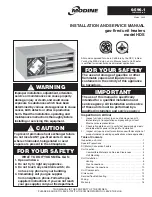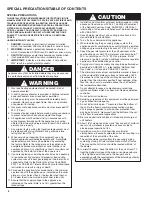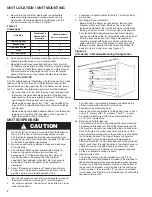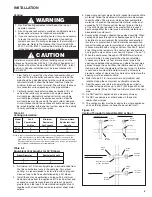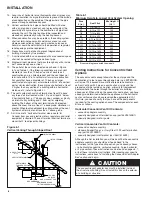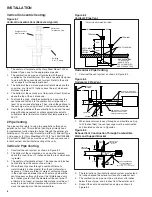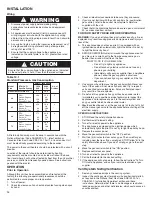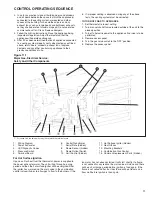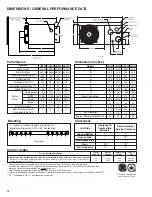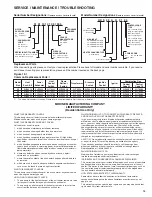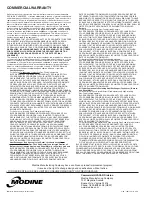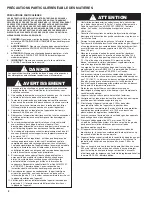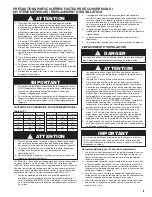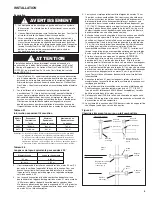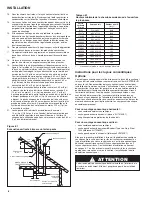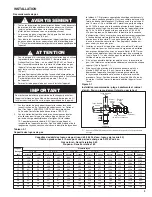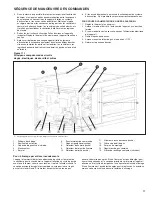
13
SERVICE / MAINTENANCE / TROUBLESHOOTING
General Maintenance
The unit and venting system must be checked once a year by a
qualified service technician.
Only people trained and familiar with the operation of unit
heaters and their controls should service this equipment.
Before any service, BE SURE TO TURN OFF GAS AT THE
MANUAL SHUT-OFF VALVE AHEAD OF THE COMBINATION
GAS CONTROL AND TURN OFF ALL ELECTRIC POWER TO
THE HEATER.
1. Service air moving components annually.
a. Check fan for fit on motor shaft and for damage to blades.
2. Keep unit free from dust, dirt, grease, and foreign matter,
paying particular attention to:
a. Combustion air inlets.
b. Burners and burner orifices. Turn off gas ahead of the
combination gas control and shut off electric power to
the heater. Remove the access panel, open the union on
the gas line, and disconnect the igniter and sensor wires.
Remove the screws that attach the burner tray to the
header plate and remove the burner tray and manifold
assembly from the heater. Carefully clean the burners
with a wire brush or other suitable means.
Replace any damaged or deteriorating burners or orifices.
Install the burner assembly back on to the header making
certain that all screws, pipes and electrical connections are
tight.
CAUTION: Be careful when handling the igniter.
1. Inspect the flame sensor and igniter for deterioration
and/or cracks.
2. Verify that the burners are touching each other
at the carryover points. This will ensure flame
carryover from burner to burner.
c. Clean exterior of heat exchanger tubes.
d. Fan
blade.
3. Check wiring for possible loose connections.
4. Controls – See control instruction sheets furnished
separately with the unit heater.
5. Power exhaust assembly/motors – The power exhaust
motor bearings have been lubricated for long life and do not
require additional lubrication. In dirty atmosphere, it may be
desirable to clean the motors and blower housing and blow
out the cooling air passages of the motor with compressed air.
6. Perform periodic cleaning of inlet and vent terminal screens.
CAUTION
1. Servicing or repairing of this equipment must be performed
by a qualified service agency.
2. Do not attempt to reuse any mechanical or electrical
controllers which have been wet. Replace defective controller.
WARNING
When servicing or repairing of this equipment, use only
factory- approved service replacement parts. A complete
replacement parts list may be obtained by contacting the
factory. Refer to the rating plate on the appliance for complete
appliance model number, serial number, and company
address. Any substitution of parts or controls not approved by
the factory will be at the owner’s risk.
IMPORTANT
To check most of the Possible Remedies in the troubleshooting
guide listed in Tables 13.1 and 13.2, refer to the applicable
sections of the manual.
Table 13.1
Troubleshooting
TROUBLE
POSSIBLE CAUSE
POSSIBLE REMEDY
Unit does nothing.
1. Power supply is off
1. Turn on main power.
2. No 24V power to thermostat
2 a. Check control transformer
b. If failed transformer - check thermostat wire gage and length
3. Thermostat malfunction
3 a. Verify wire connections to R&W terminals only
b. Check / replace thermostat
4. LED flashes bright / dim
4. Check LED code at gas valve thermostat and connection
5. Defective control
5. Replace control
LED light off or flashing.
1. Light off - no power
1. Check main power
2. Two flashes - pressure switch closed.
2 a. Check for blocked or improper venting.
b. Check vent motor hose / connection replace or reconnect
c. Check pressure switch.
d. Check power exhauster motor.
3. Three flashes - pressure switch open.
3 a. Check to insure control switch in "ON" position
b. Check for incorrect or blocked venting
c. Check pressure switch
4. Four flashes - limit or flame rollout switch
4 a. Check limit and flame controls and connections
b. If flame rollout switch OK, but tripped:
1. Main gas pressure too high
2. Manifold orifice incorrect - too large
3. Incorrect unit clearance to surrounding wall/ceiling
4. Check for negative pressure in building
5. Incorrect or blocked venting
6. Access panel vent louvers wrong direction - reverse panel.
7. Area around main gas orifices blocked with debris
8. Unit louvers closed.
9. Heat exchanger tube(s) blocked with debris
5. Five flashes - Flame signal sensed
5. Flame at main burners
out of sequence.
6. Six flashes - System lockout
6 a. Gas supply off or too low.
b. Damaged or broken Ignitor.
c. No line voltage.
d. Unit not properly grounded.
e. Check flame sense rod.

